Mindful Leadership - Five Arts of Leadership For Buddhist Youth Leaders: With An Emphasis on Awareness Practice
View: 1250 - Thích Nữ Thuần Tuệ, Tâm Thường Định 1/10/2019 09:10:16 pm

Abbess Thích Nữ Thuần Tuệ and Tâm Thường Định
Right Mindfulness, Sammà sati in Pali, means to think positive thoughts, to be enlightened in that moment, and to comprehend all Dharma completely. Mindfulness is an integral part of the Noble Eightfold Path—the eight methods of the path to peace and liberation—within the fourth Noble Truth. According to Theravada Buddhist tradition, mindfulness is the heart of meditation and conscious awareness of all phenomena that arise in the present moment. In other words, mindfulness is to know what is currently occurring. Mindfulness is the energy that originates from self-observation of what is going on internally and externally. Mindfulness brings us back to the present moment since the present is a beautiful gift that we can treasure here and now.

In accordance with Buddhist tradition, mindfulness is essential to the development of Right Concentration (Sammà samadhi), the method used to receive and maintain moral conducts in life. Mindfulness has many functions. The first one is to recognize everything that is occurring presently. The second function is awareness of thoughts that arise in our mind. Gradually, mindfulness guides practitioners to Right Concentration, and, ultimately, Perfect Wisdom.
Leadership, by our definition, is to guide others in the spirit of giving without expecting any reciprocation, and helping ourselves along with others indiscriminately. Normally, a good leader possesses the following three traits:
1. Have a benevolent vision and the capability to positively inspire and influence others in mindfulness.
2. Advocate and transmit that ideal vision to fellow practitioners and oneself via his/her practice of mindfulness.
3. Instill joy, benefit, and peace to oneself and others at this very moment and future moments.
Mindful leadership allows “the leader” to transcend the boundaries of time and space in order to bring peace to everyone. This transcendence is only possible if the leaders’ thoughts, speech and actions stem from altruism and compassion. In this spirit, we would like to share this topic on Mindful Leadership to the leaders of the Vietnamese Buddhist Youth Association (Gia Đình Phật Tử) in particular and all beings as a whole.
The art of mindful leadership consists of five main points:
1. Deep listening and empathy
2. Sound judgment
3. Living in harmony with others
4. Teaching through actions
5. A kind heart
We will begin with the word “Huynh Trưởng,” which means an older brother, an older sister, or someone with experiences whose responsibility is to protect and guide younger members (đàn em). A role model Huynh Trưởng needs to be calm, caring, tolerant, and sound in order to fulfill their aforementioned tasks. A Huynh Trưởng is an active member with duties and responsibilities toward the VBYA. A Huynh Trưởng guides and nurtures younger members while accepting and fulfilling tasks/activities to sustain and grow the VBYA local chapter (đơn vị). Lastly, a Huynh Trưởng is an excellent citizen and contributes constructively to society. Leadership is an art filled with dedication. Here is a classic example:
Long ago, the president lectured about leadership at a United States Military Academy. He took out a bundle of rope from his pocket and placed it on a table. He challenged students to push the rope across the table; many students attempted this task, but they all struggled to push the rope across the table. As they pushed, the rope would curl, twist or tangle; it was an impossible task!
After all students conceded, the president laughed kindly and slowly rearranged the rope back to its original position. Next, with his thumb and index finger, he pulled the rope along the table. The remaining rope followed his hand and glided across the table effortlessly. The president explained, “People are like a bundle of rope. If we lead them, they will follow. But if we push them, they will push back, creating unwanted complications.”
To be capable leaders, we need to practice, understand, and apply teachings like the Five Vidyas (Ngũ Minh) and Three Teaching Methods (Thân Giáo, Khẩu Giáo, Ý Giáo). Remember, a person that does not know direction cannot navigate another person and a person without money cannot donate money to anyone. Likewise, a leader cannot share knowledge and skills that they are not comfortable explaining in detail. In order to teach and guide younger members, a leader first needs to be trained accordingly.
Generally, everyone wants to be a good, admirable, and kind person, but flaws and bad habits are difficult to hide. Gradually, young members will learn to not trust a leader with glaring flaws, noticeable bad habits, and lackadaisical efforts. A leader can try to hide his/her shortcomings; however, the truth cannot stay hidden forever.
Practicing mindfulness allows leaders to rapidly improve themselves. Normally, the mind constantly wanders every day, everywhere; and therefore, mindfulness reminds the mind to return to the present. Mindfulness brings the mind home. Mindfulness grants the practitioner the ability to be in true contact with the people and situations at hand. Intangible - mindfulness cannot exist in the form of thoughts but can be perceived by keen hearts.
Below are details associated with the Art of Mindfulness.
I. DEEP LISTENING AND EMPATHY
1. Be Silent
Please listen to the whole sentence. Please do not respond immediately. Please do not jump to conclusions. Please be empathetic to others’ difficulties.
I like to share this short Zen anecdote titled “Say and Listen” from Zen Master Gettan (Nguyệt Am). The Zen Master frequently reminded his students that “When you use your mouth to speak, your ears are not listening. When you use your ears to listen, your mouth is not speaking. Please contemplate this notion.”
2. Be empathetic
Life often has two facets: an obvious facet and a more subtle one. Here is another example:
Not too long ago in Vietnam, a neighbor complained to his elderly friend:
“The neighboring house just bought a karaoke machine. My God! The little girl sang like a moaning cow. And the son… He roared like a tiger. I have headaches listening to them. “
The elder friend calmly replied, “I feel the same way. But those kids are not out drinking alcohol, stealing from villagers, or harming the village. Those actions are more troublesome; therefore, we must be more tolerant for the village’s safety.”
Below is another example:
It was afternoon and kids were asleep in the nursery. John was thirsty and went to Miss Roberts’. He whispered, “May I have some water?”
Half-asleep, Miss Roberts awoke grumpily and unpleasantly answered, “Allowed.”
“Miss Roberts, may I have some water?” John asked again. This time his voice was a bit louder.
Annoyed that John was asking again, she responded with a loud, “Allowed.”
“Miss Roberts, may I have some water?” John asked the same question for the third time. This time his voice was very loud.
“Allowed.” Miss Roberts yelled her answer.
“MISS ROBERTS! MAY I HAVE SOME WATER?” John scream with all his might, waking up all the sleeping children. Angered, Miss Roberts lost her temper and yelled, “John! Are you messing with me?”
Scared and confused, John answered, puzzled, “No, Miss Roberts. You told me to say aloud!”
What happened in this comical short story? Why did John misunderstand Miss Roberts’ words? When Miss Roberts answered with “allowed,” John misheard and thought Miss Roberts said “aloud.” This is an example of homophones; words that sound similar but have different meanings. To distinguish between homophones, we use context, but John has yet to learn about homophones and reacted inappropriately. Miss Roberts overlooked the situation and wrongly assumed John was playing a game.
In general, a leader needs to remember:
· Do not control others.
· Do not expect others to see your viewpoints.
· Do not depend on others for happiness.
President Abraham Lincoln famously said, “I destroy my greatest enemies when I make them my friends.” Similarly, a leader needs to focus on the positive aspects his team possesses rather than the weaknesses within the team.
3. Sharing is leadership
Please use this story about changing people’s lives as an example:
In the year 1921, Lewis Lawes served as warden for the Sing Sing Correctional Facility, a prison known for its harsh conditions. Twenty years later, upon his retirement, this prison had transformed into a humane site. When asked about these remarkable transformations, Lawes credited his wife, Kathryn, for instilling these changes.
Even before her first visit to the Sing Sing Correctional Facility, Kathryn heard many rumors about this dreadful place and its prisoners. Her first visit to the prison was during its first basketball game held between prisoners. Kathryn sat and watched with her children among prisoners. She felt neither fear nor repulsiveness. She believed these prisoners would treat her well since she and her husband treated them well.
When she saw a blind man that was convicted with murder, she held his hands and tenderly asked whether he knew Braille. He did not. She taught him how to read. Upon meeting prisoners that were mute and deaf, she learned and taught sign language to them. From 1921 to 1937, prisoners within the Sing Sing Correctional Facility viewed Kathryn as a living saint, an angel.
When Kathryn died from a car accident, Lewis Lawes took leave to oversee his wife’s funeral. The vice-warden saw how these so-called cruel prisoners gathered in front of the main gate; their faces were filled with tears. He knew how much they loved and appreciated Kathryn. Thus, he allowed them to leave the facility without any supervision from guards as long as they returned by nighttime. All prisoners walked over a kilometer of distance to attend Kathryn’s funeral and returned to Sing Sing on time as promised.
4. Avoid jumping to conclusions
The act of judging a person is actually the mind trying to manifest itself. To better ourselves, we should stop judging others.
a. Please use this short story as an example. One day, the father brought home a beautiful bird inside a cage; he hung the cage on a tree in the garden. The mother also brought home a cute cat, which could roam freely. A few days later, the father returned home and did not see his prized bird; meanwhile, the cat was sunbathing in the garden. The father blamed the cat for eating his precious bird while the mother fervently defended her cat. They quarreled non-stop. Angered, the father left the house for work while the mother went back to her parent’s house, carrying the youngest child. Later that night, the neighbor brought over the lost bird, which flew out of his opened cage, but no one was home except for the servants.
b. This famous story called “Nhan Hồi and the rice pot” is another beautiful example. During the Eastern Zhou time period of Ancient China’s history, Confucius led a pilgrimage from Lo, his homeland, to Qi, a thriving city-state. Among his many distinguished students, Nhan Hồi (Yan Hui) and Tử Lộ (Min Sun) were the most recognized and favorite ones. At that time, wars between neighboring city-states were frequent and long-lasting. People struggled for survival; starvation and misery were common everywhere. Confucius and his students also suffered the same fate. On their journey, they starved for many days; their meals consisted simply of vegetables and porridge. Despite these rigorous and extreme conditions, all students followed their teacher’s journey with determination. Fortunately, upon reaching Qi, a merchant recognized Confucius and donated rice to the group. Confucius entrusted Tử Lộ to his remaining students in search for vegetables in the forest. Meanwhile, Nhan Hồi was designated the task of cooking rice. Nhan Hồi was given this crucial and important task since he was a virtuous person, for whom Confucius had trust and high expectations.
Nhan Hồi began cooking the rice as the group led by Tử Lộ left to find vegetables. Meanwhile, facing the kitchen, Confucius was reading old doctrines. Suddenly, Confucius heard a loud noise emerging from the kitchen. He looked toward the kitchen to see Nhan Hồi opening the rice pot’s lid, stirring the cooked rice with chopsticks. Once finished, glancing around, Nhan Hồi slowly ate the rice.
Confucius witnessed all of Nhan Hồi’s actions and sighed to the Heaven in disappointment, “Oh! My best student! He ate before his teacher and friends… What a scoundrel! How could all my expectations suddenly disappear into thin air…”
A moment later, Tử Lộ returned with vegetables, which Nhan Hồi steamed in boiling water. In misery, Confucius continued to remain in silence. When the vegetables were cooked, Nhan Hồi and Tử Lộ prepared the table for dinner. Once everything was ready, all students gathered to invite Confucius for dinner. Looking at his students, Confucius said, “My students. The journey from Lo to Qi was long and tiresome. I am pleased that you remain pure at heart, continue to love and protect each other, and follow my teachings despite harsh and starving conditions. Today, our first day in Qi, we are blessed with a warm meal. This first meal in Qi reminds me of my homeland, Lo. I remember my parents. I want to offer a bowl of rice to my parents. May I?”
All students except Nhan Hồi folded their hands and answered, “Yes!”
Confucius continued, “I want to ensure that this rice is pure first.”
Confused, his students glanced around for an answer. At that moment, Nhan Hồi folded his hands and answered, “My dear teacher, this rice is not pure.”
Confucius asked, “Why?”
Nhan Hồi answered, “When I opened the lid to check whether the rice had evenly cooked, a gust of wind blew by causing soot and dusts to fall into the rice. I tried to stop these debris from soiling the rice but I could not block them all. I immediately removed the soiled rice and was about to discard them, but then I thought: We have a lot of people, but we are short on rice. If I discard these soiled rice, we will be short a serving portion of rice, and everyone will eat less. Therefore, I dared to eat the soiled rice beforehand. I dedicate these clean rice to you, my teacher, and my friends.
“Dear teacher! I have already eaten my portion of rice for today. Please excuse me from eating rice this meal. I will just eat vegetables. And lastly, we should not offer rice that has been eaten as a worship.”
After hearing Nhan Hồi’s response, Confucius looked up to the Heaven and exclaimed, “Alas! There are things in this world that you clearly see but still cannot comprehend the truth. I almost became a fool!”
II. SOUND JUDGMENT
A leader needs to be a role model and an embodiment for wisdom in order to safely guide and benefit followers. When our mind resides in mindfulness, our mind is not lost in thoughts and is in true contact with the present situation. This mental state allows us to find the best solution to any given problem.
Consider this short story. A group of merchants traveled under the hot sun without an adequate supply of water. Upon entering a new village, the group saw a huge tree full of ripe, juicy fruits. The group yelled in excitement and began climbing the tree. Suddenly, the leader stopped everyone:
“My friends. You should not eat these fruits. If these fruits were indeed edible, villagers and other travelers would have eaten them already. Since these fruits have not been eaten, these fruits are poisonous.”
Listening to the leader’s sound judgment, the group continued forward.
Another group of merchants arrived at the exact same location shortly. Everyone in the group quickly devoured these fruits. As expected, these fruits contained toxins, and the whole group was poisoned. In this instance, the leader lacked the needed wisdom to guide and protect his group to safety.
The Buddha taught us:
1. Address the problem promptly and facilitate discussion. Be aware that unhappy people do not like to be lectured. Remember the story regarding Gotami and her dead child. The Buddha did not lecture Gotami but instructed her to seek a family that had not experienced death. Gotami eventually realized the truth regarding death.
2. State the facts. Avoid explanations and accusations based on self-analysis or self-speculation. Avoid exaggerations and elaborations.
3. Use neutral words that are not biased.
4. Speak with an intention of benefitting the audience. Focus on positive aspects within the situation. Avoid criticisms that lead to arguments.
5. Speak from compassion, not from anger.
Furthermore, The Buddha also emphasized: “Sariputta, although you have followed these five methods of dialogue, there are people that still will not change. This is due to pre-conceived notions (sở tri chướng) within them.”
III. LIVING IN HARMONY WITH OTHERS
1. Recognize our ego
Mindfulness and ego cannot and will not coexist. Ego intrinsically causes confrontation and disagreement since ego has the tendency to want to be correct, to be the best, to be the alpha, to be number one. Everyone has this ego. Whenever our ego feels superior, we react boastfully; whenever our ego feels inferior, we react aggressively. To protect and strengthen itself, each individual ego clashes with other egos, creating conflicts. Sadly, we fail to recognize that we are inadvertently hurting others as we satisfy our ego.
To live in harmony, our ego needs to be lowered and we must be more accepting. We should live with this motto: respect our superiors, love our inferiors, and tolerate our equals.
2. Right and wrong
Never be one-hundred percent certain that you are correct, for being correct leads to arguments and conflicts. Our definition of correct only applies to ourselves; as a result, others probably have different viewpoints and will not accept our point-of-views. Being less certain causes less controversy, conflict, and anger from happening.
If we respect the viewpoints of others and acknowledge others’ logics, we can live and work in harmony for eternity.
Venerable Zen Master Thích Thanh Từ once said, “We often have a tendency to believe our thoughts are absolute truth. Thus, our thoughts and others’ thoughts clash, leading to arguments, anger, and violence.”
Venerable Thích Thanh Từ reflected, “When I was living in the mountain, I saw rain clouds approaching my direction from afar. I wholeheartedly believed that rain was coming, so I quickly moved everything inside. However, the wind would change the clouds direction, leading to no rain. Therefore, our thoughts are never one-hundred percent correct. We tend to think we are correct; our assumption gives rise to conflict and disagreement.”
In the Sutra, the Buddha taught, “One who respects the truth would say ‘This is my thought’ and would stop talking. If one says my thought is correct, one is no longer respecting the truth. Adding the word ‘right’ creates controversy.”
3. Be calm and happy
Never view anything as absolute importance. Be optimistic and have a positive outlook. Acknowledge praiseworthy characteristics and behaviors within the people we are interacting with or the present situation. Cherish what we presently have. Do not expect everything to go according to our expectations. If we live according to principles mentioned above, our mind will be at peace. Our personal practice will generate positive energy that benefits the collective community.
IV. TEACHING THROUGH ACTIONS
In the article “Thân Giáo: Có thể là một giải pháp cho tất cả”, I emphasize that Buddhism is based on the principles of compassion and wisdom, cultivated through personal practice. Teaching through actions is a valuable and practical lesson that the Buddha taught since we can easily apply this practice to daily life in multiple instances. The evolution in international peace can be traced to the Buddha’s teachings. Nowaday, Buddhism remains a solution to most modern problems within society. As the author, I raise the following seven points:
1. Establish a humane mindset
2. Comprehend cause and effect with karma
3. Improve our surroundings
4. Practice mutual respect and mutual benefit
5. Be there to assist others
6. Remember strength in numbers
7. Be a Buddhist practitioner
In general, a leader needs to earn others’ trust and cooperate with others in the spirit of compassion and altruism. This is only possible when a leader possesses both respect and affection toward others. A reliable leader is someone younger members can depend on and learn from in multiple situations.
· One should acts as one teaches others
· Only with oneself through thoroughly tamed should one tame others
· To tame oneself is, indeed, difficult.
· -Excerpted from Verse 159 of the Dhammapada
Our actions reflect the degree of our personal practices, which are based on precepts, perseverance, and diligence. With compassion and vows to benefit others, the Buddha attained enlightenment to guide and save people from suffering.
1. Practice mindfulness
Be conscious of your actions. Unite the mind and body. For example:
a. While walking, be aware of which foot you are moving. Be aware of each movement you make within the day.
b. Mindfulness can prevent mental illness like Alzheimer’s disease. Remember forgetfulness and unawareness hinder the accomplishment of goals.
2. Practice awareness
a. Be aware of the 6 senses. Know the present clearly and uninterruptedly.
b. Realize when our mind drifts toward self-attachment and unkind thoughts.
c. Live in the present. Relax body and mind.
3. Wisdom and compassion are the two doors that lead to liberation.
4. Lead ourselves
In order to lead, a leader must have high self-esteem and peoples’ trust. People trust and listen to a leader because that leader is caring and devoted not because that leader possesses power.
5. Flagrance diffuses from the flower
Cultivate spiritual energy through personal practices. Share that cultivated energy with the collective.
6. Results do not fall from the sky.
Genius cultivates good habits that are accumulated from previous lives or decades of intense hard work and dedication.
V. A KIND HEART
A good leader consistently reflects on whether understanding, love, and unity are more important than being right.
Years ago, a Hindu follower undertook a pilgrimage toward a holy temple within the Himalayan mountains. The road was long, steep, and windy; the condition was hot and oxygen level was low due to the elevation. Despite carrying little to no supply, he hiked vexingly while breathing heavily. Oftentimes, he stopped to rest while wishing his destination would appear before him. Suddenly he saw a young girl about 10-years-old walking toward him. Gasping for breath and sweating profusely, she was piggybacking a small child with all her might.
The Hindu follower approached the young girl and sympathetically spoke, “My dear child. You must be as tired as me. You carry a heavy load!”
The girl corrected, “What you carry is weight. What I carry is my brother, not weight.”
The follower’s load feels heavy because he does not possess love. Love provides us with the strength to face adversities with ease. Life is meaningful when we live with true love and aim toward clear ideals.
Love requires sacrifice. Without love, a sacrifice will definitely feel like a burden. This world will become more beautiful if everyone shares responsibilities and obligations that benefit the collective, including family, community, and religion.
Everyone lives a meaningful life while shouldering a very gentle burden together and sharing fraternal love as we aspire toward that common, lofty goal.
From these short vignettes, I summarize the main points in the following poem:
Mindful Leadership
· Deep listening and sympathy
· Calm in all instances
· Harmony from accordance
· Sound and wise decisions
· No anger, ignorance, flattery
· Hone the Four Assistant Methods (Tứ Nhiếp Pháp)
· Maintain a pure mind
· Define Mindful Leadership
CONCLUSION
Nowadays, technology and science continue to advance at a rate that far exceeds that of spiritual development. Whether we are monastics or lay followers, leaders or young members of the VBYA organization, male or female, young or old, members or not members of VBYA—as Buddhists, we need to practice and apply Buddhism with solemnity to transform ourselves and surroundings. We need to mend our flaws and bad habits to gradually better ourselves. In addition, we need to fulfill our duties and obligations whenever and wherever possible with fervor. Accepting our roles, duties, and responsibilities as a VBYA leader with utmost genuineness, we practice mindfulness to radiate the energy of compassion and wisdom. These spiritual energies will nourish and strengthen our younger members. That is the essence of mindful leadership. Dear friends, let’s commence our journey.
Translated by Quang Tran, Edited by Phe Bach
*Bài này đã được trình bày cho Trại Huấn Luyện A Dục Lộc Uyển của Miền Liễu Quán, năm 2016. Bài này có thể là bài học chính thức cho trại Huấn Luyện từ đây trong tổ chức GĐPT.
Pleaser read the Vietnamese version here / Hãy đọc: Lãnh Đạo Trong Chánh Niệm – 5 Nghệ Thuật Lãnh Đạo Cho Hàng Huynh Trưởng













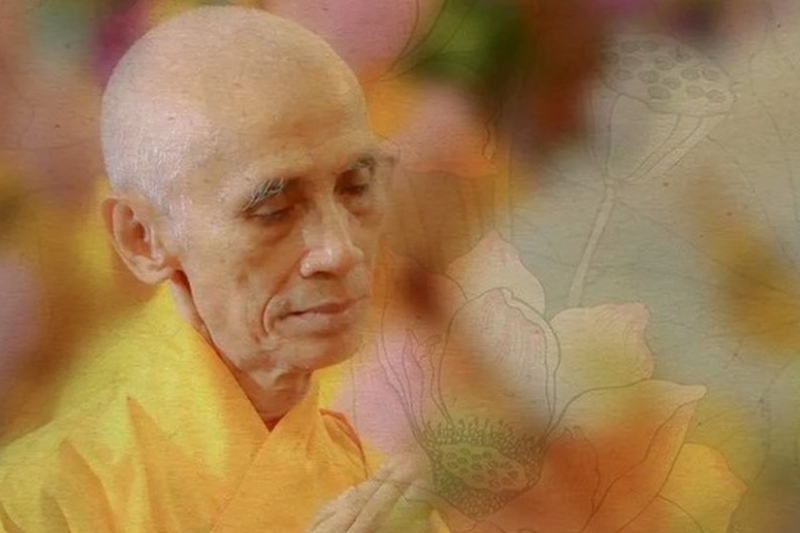
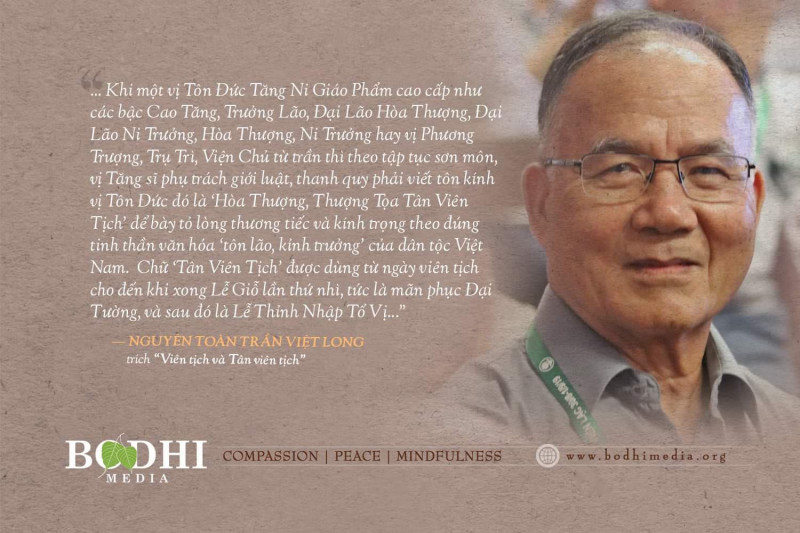




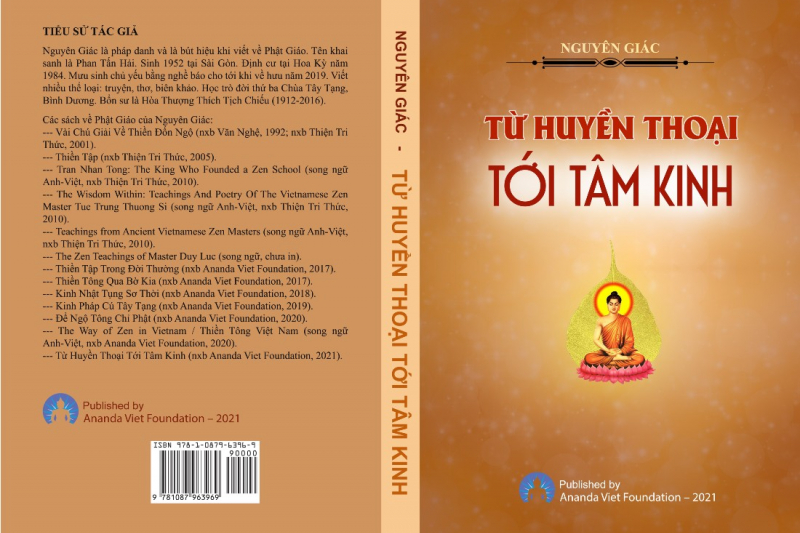
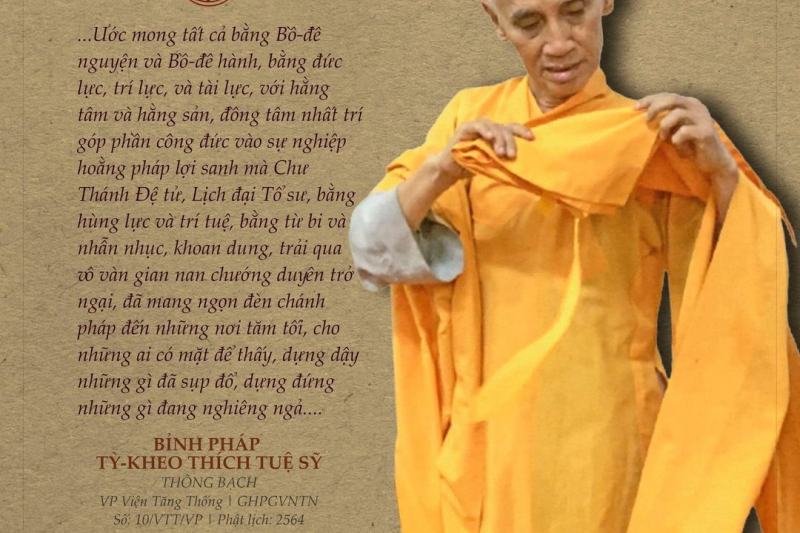

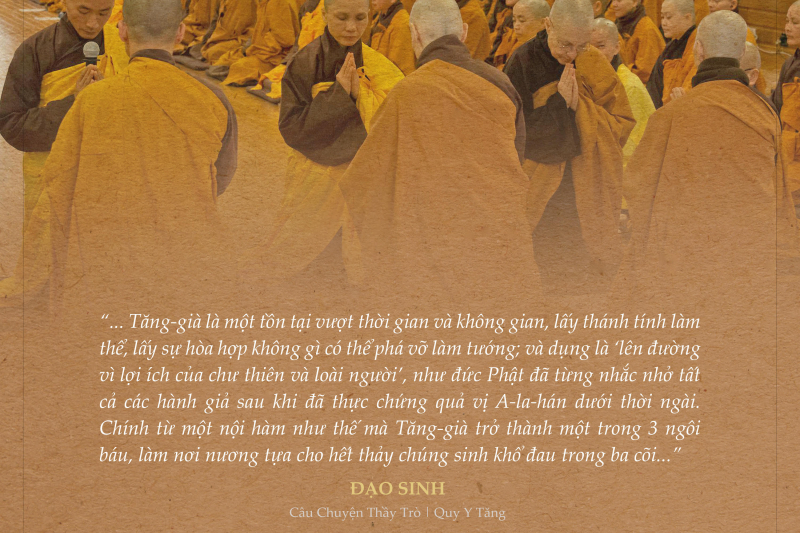
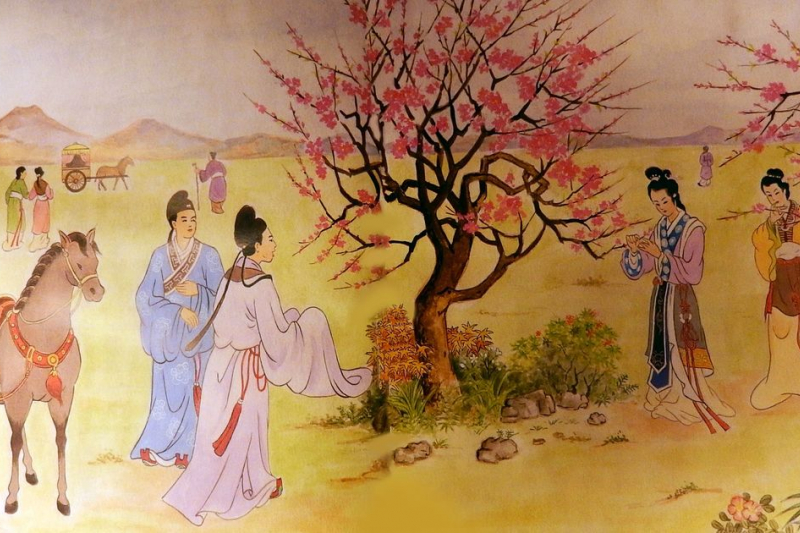











![Trung Đạo [S. madhyamapratipad; P. majjhimapaṭipadā; T. dbu ma’i lam; 中道; middle way]](biasach/small/365.jpg)
